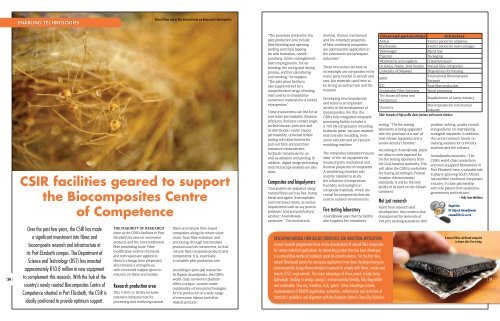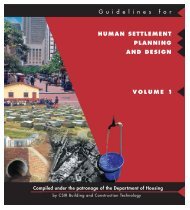Research and development for industry: Advanced ... - CSIR
Research and development for industry: Advanced ... - CSIR
Research and development for industry: Advanced ... - CSIR
Create successful ePaper yourself
Turn your PDF publications into a flip-book with our unique Google optimized e-Paper software.
ENABLING TECHNOLOGIESNatural fibres such as flax (pictured here) are being used in biocomposites.<strong>CSIR</strong> facilities geared to supportthe Biocomposites Centreof Competence“The processes involved in thepilot production line includefibre blending <strong>and</strong> opening;carding <strong>and</strong> cross lapping<strong>for</strong> web <strong>for</strong>mation; needlepunching;hydro-entanglement;foam impregnation; hot airbonding; the curing <strong>and</strong> dryingprocess; <strong>and</strong> hot calendaring<strong>and</strong> winding,” he explains.“The pilot plant facility isalso supplemented by acomprehensive range of testinginstruments to characterisenonwoven materials <strong>for</strong> a varietyof properties.”These instruments can test <strong>for</strong> air<strong>and</strong> water permeability; filtrationefficiency, dynamic contact angle;surface tension; pore size <strong>and</strong>its distribution; water-vapourpermeability; universal tensiletesting with attachments <strong>for</strong>pull-out <strong>for</strong>ce <strong>and</strong> punctureresistance measurement;hydraulic transmissivity; aswell as abrasion <strong>and</strong> peeling. Inaddition, digital image processing<strong>and</strong> microscopy analysis are alsodone.Composites <strong>and</strong> biopolymers“Composites are prepared usingnatural fibres such as flax, hemp,kenaf <strong>and</strong> agave; thermoplastic<strong>and</strong> thermoset resins; as well asbiopolymers such as soy protein,polylactic acid <strong>and</strong> polyfurfurylalcohol,” An<strong>and</strong>jiwalacontinues. “The mechanical,thermal, thermo-mechanical<strong>and</strong> fire-retardant propertiesof fibre-rein<strong>for</strong>ced compositesare optimised <strong>for</strong> application inthe automotive <strong>and</strong> aerospaceindustries.”These two sectors are keen toincreasingly use composites in themany parts needed in aircraft <strong>and</strong>cars, but materials used have tobe strong as well as heat <strong>and</strong> fireresistant.Developing new biopolymers<strong>and</strong> resins is an importantactivity in the <strong>development</strong> ofbiocomposites. For this, the<strong>CSIR</strong>’s fully integrated compositeprocessing facility includes a2 700 kN compression mouldinghydraulic press, vacuum-assistedresin transfer moulding, twinscrewextruder <strong>and</strong> an injectionmouldingmachine.The composites laboratory housesstate-of-the-art equipment <strong>for</strong>measuring the mechanical <strong>and</strong>thermal properties of composites.A weathering chamber wasrecently installed to studythe influence of temperature,humidity <strong>and</strong> sunlight oncomposite materials, which arecrucial <strong>for</strong> components that areused in outdoor environments.Fire testing laboratoryAn<strong>and</strong>jiwala says that the facilityalso supports fire-retardancyClient <strong>and</strong> partnershipsAirbusBombardierVolkswagenExpericoWoolworths <strong>and</strong> suppliersDe Gama, Frame, Brits TextilesUniversity of DelawareBIRNIDCSustainable Fibre SolutionsThe House of Hemp <strong>and</strong>Hemporiumtesting. “The fire testinglaboratory is being upgradedwith the purchase of a rate-ofheat-releaseapparatus <strong>and</strong> asmoke density chamber.”According to An<strong>and</strong>jiwala, plansare afoot to seek approval <strong>for</strong>the fire testing laboratory fromthe Civil Aviation Authority. Thiswill allow the <strong>CSIR</strong> to undertakefire testing according to FederalAviation Administrationst<strong>and</strong>ards. It will be the onlyfacility of its kind on the Africancontinent.Not just researchApart from research <strong>and</strong><strong>development</strong>, this centre is alsocharacterised by elements of<strong>industry</strong> seeking assistance withInitiativesInterior panels <strong>for</strong> airplanesInterior panels <strong>for</strong> train carriagesParcel trayPackagingCharacterisasionNatural fibre compositesBiopolymers <strong>for</strong> housingInternational BiocompositesNetworkSisal fibre productionKenaf processingEstablishment of hemp <strong>industry</strong>Biocomposites <strong>for</strong> constructionChemcity<strong>industry</strong>Table: Examples of high-profile clients/partners <strong>and</strong> research initiativesproblem-solving, quality control,<strong>and</strong> guidance on maintainingecological st<strong>and</strong>ards. In addition,the centre conducts h<strong>and</strong>s-ontraining sessions <strong>for</strong> universitystudents <strong>and</strong> the <strong>industry</strong>.An<strong>and</strong>jiwala concludes: “The<strong>CSIR</strong>’s world-class researchers<strong>and</strong> well-equipped laboratories inPort Elizabeth have a valuable roleto play in growing South Africa’snatural fibre-rein<strong>for</strong>ced composites<strong>industry</strong>, in close partnershipwith role players from academia,government <strong>and</strong> <strong>industry</strong>.”– Kelly-Anne MatthewsEnquiries:Dr Rajesh An<strong>and</strong>jiwalaran<strong>and</strong>i@csir.co.za| 50 |Over the past few years, the <strong>CSIR</strong> has madea significant investment into fibres <strong>and</strong>biocomposite research <strong>and</strong> infrastructure atits Port Elizabeth campus. The Department ofScience <strong>and</strong> Technology (DST) has investedapproximately R10.8 million in new equipmentto complement this research. With the hub of thecountry’s newly created Biocomposites Centre ofCompetence situated in Port Elizabeth, the <strong>CSIR</strong> isideally positioned to provide optimum support.The majority of researchdone at the <strong>CSIR</strong>’s facilities in PortElizabeth focuses on nonwovenproducts <strong>and</strong> the more traditionalfibre processing route. Fibremodification (where chemicals<strong>and</strong> techniques are applied tofibres to change their properties)also remains a strong focus,with continued support given to<strong>industry</strong> on fibres <strong>and</strong> textiles.<strong>Research</strong> production areaThis 4 300 m 2 facility includesextensive infrastructure <strong>for</strong>processing <strong>and</strong> analysing naturalfibres <strong>and</strong> natural fibre-basedcomposites along the whole valuechain, from fibre extraction <strong>and</strong>processing, through intermediateproducts such as nonwovens, to finalnatural-fibre composite products <strong>and</strong>components. It is, essentially,a complete pilot production line.According to principal researcherDr Rajesh An<strong>and</strong>jiwala, the <strong>CSIR</strong>’sworld-class nonwoven plat<strong>for</strong>moffers a unique, custom-madecombination of several technologies<strong>for</strong> the production of a wide rangeof nonwoven fabrics <strong>and</strong> otherrelated products.Developing natural fibre-based composites <strong>for</strong> industrial applicationsCurrent research programmes focus on the <strong>development</strong> of natural fibre composites<strong>for</strong> various industrial applications. An interesting product that has been developedis a natural fibre-rein<strong>for</strong>ced s<strong>and</strong>wich panel <strong>for</strong> aircraft interiors. For the first time,natural fibre-based panels <strong>for</strong> aerospace applications have been developed using anenvironmentally benign flame-retardant treatment to comply with flame, smoke <strong>and</strong>toxicity (FST) requirements. The major advantages of these panels include beinglightweight (leading to energy savings), environmentally friendly, fully degradable<strong>and</strong> sustainable. They are, there<strong>for</strong>e, truly ‘green’. Other advantages includeimplementation of REACH (registration, evaluation, authorisation <strong>and</strong> restriction ofchemicals) guidelines <strong>and</strong> alignment with the European Union’s Clean Sky Initiative.A natural fibre-rein<strong>for</strong>ced compositeis shown after fire testing.| 51 |
















